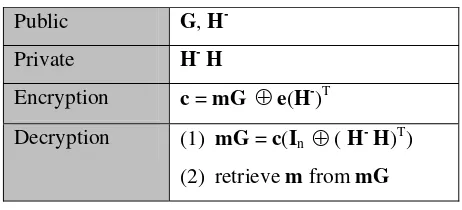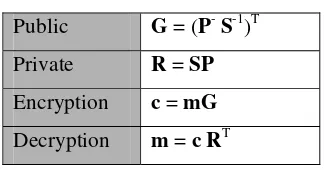1 RIGHT INVERSE IN PUBLIC KEY CRYPTOSYSTEM DESIGN1
By Budi Murtiyasa2
Department of Mathematics Education
Faculty of Education and Training Muhammadiyah University of Surakarta
Abstract
The theory of matrices becomes a potential tool in cryptographic research. The paper addreses to develop a public key cryptosystem based on right inverse of matrices. The idea is similar to the previous public key cryptosystem, that is McElice’s public key and Wu-Dawson’s public key, in term of the usage of a coding theory. Properties of the public key cryptosystem are analyzed and compared with the previous public key cryptosystem.
Key word : right inverses, public key cryptosystem
Introduction
For a public key cryptosystem with information expansion, i.e. the length of ciphertext
blocks is larger than that of plaintext blocks, it is possible that one plaintext block may
correspond to several valid ciphertext blocks. For example, McEliece’s public key cryptosystem
and Wu-Dawson’s public key cryptosystem have information expansion (Wu and Dawson,
1998:321). Both of them have an advantage that is fast encryption and decryption. Disadvantages
need large key space and have message expansion.
This paper proposes a public key cryptoystem based on the right inverses of matrices in
the field Z2 = {0, 1}. The algorithms of encryption and decryption, which are linear operation,
can be performed very quickly. Properties and risk analysis of the public key cryptosystem are
discussed by comparing with McEliece’s and Wu-Dawson’s public key cryptosystem.
Encryption by McEliece’s public key can be explained as follows. For a message m,
ciphertext c = mG’ ⊕ e, G’ = SGP, where G is a kxn generator matrix of linear code C[n,k], S
is a kxk a nonsingular matrix, P is a nxn permutation matrix, and e is a binary vector of length n
with Hamming weight t. G’ is public, and G, S, and P are secret. Conversely, the decryption
process of ciphertext c to obtain the plaintext m are : (1) compute c1 = cP-1, (2) m1 = c1 ⊕ e1, (3)
retrieve m0 from m0G = m1, (4) compute m = m0S-1 (Stinson, 1995:196). Meanwhile,
Wu-Dawson’s public key can be summarized as in Table 1 below.
In Table 1, c is a ciphertext of a message m, G is a kxn generator matrix of linear code
C[n,k], H is (n-k)xn parity check of matrix, H-isnx(n-k) generalized reinverses of matrix H. (Wu and Dawson, 1998:323).
1 Prensented on IndoMS Conference at Faculty of Mathematics and Natural Sciences Udayana University
Denpasar Bali Indonesia, 26 – 30 July 2004.
2
Table 1. Wu-Dawson’s public key cryptosystem
-3
Proof : the number of different right inverses of A is the number of different choices of W which
4
see for detail on error correcting code (Vanstone and Oorschot, 1989; MacWilliams and Sloane,
1993). By reconstruction of generator matrix G, that is G = (P-S-1)T, the ciphertext of plaintext m
with length k is c = mG. S is a kxk non-singular matrix, and P is a kxn matrix with rank k. Matrix
G is public to encrypt message m. The decryption to obtain message m can be performed as
follows : compute c(SP)T = mG(SP)T = m (P-S-1)T (SP)T = m (S-1)T (P-)TPTST = m.
The above description can be summarized as in Table 2 below.
Table 2. Public key cryptosystem
Public G = (P-S-1)T
Private R = SP
Encryption c = mG
Decryption m = c RT
A key generation of the public key cryptosystem can be performed according to the
following steps : (1) select G1 = [Ik A] with an arbitrary kx(n-k) matrix A, (2) select an arbitrary kxk nonsingular matrix S, (3) P = SG1 , (4) find a right inverse of P, i.e. P-, (5) find inverse of S,
i.e. S-1, (6) G = (P-S-1)T, (7) R = SP. Thus, R is a private key and G is a public key.
Properties of the Cryptosystem
1. Key space.
The public key space is size of G, which iskn bits. Meanwhile, the private key space is size
of R, which is also kn bits. So, the total of key space needs 2kn bits.
2. Encryption and decryption complexity.
I assume that both binary addition and multiplication are bit operation. For encryption,
computation c = mG needs (k + k – 1)n = (2k –1) n = 2kn – n. Encryption complexity is the
order of O(kn). For decryption, ciphertext c has length n, so that computation m = cRT needs
(n + n – 1)k = (2n –1)k = 2kn – k. Decryption complexity is the order of O(kn). Therefore,
both encryption and decryption process needs 2kn – n + 2kn – k = 4kn – k – n . So,
encryption and decryption complexity are also the order of O(kn).
3. message expansion.
A cryptosystem is said to have message expansion if the length of ciphertext blocks is longer
than the length of the plaintext blocks. If r denotes the proportion of the length of the
5
Table 3. Comparison of cryptosystem
Cryptosystem Private key
space
Public
key space
Complexity of encryption and
decryption
Ratio of message
expansion
My
cryptosystem
kn kn 4kn – n – k Æ O(kn) n/k
McEliece k2 + kn + n2 kn 2kn+(2n-1)n+(2k-1)k Æ O(n2) n/k
Wu-Dawson n2 2kn n3 + 3n2 – 2n Æ O(n3) n/k
From Table 3 above, it can be concluded that the cryptosystem are:
(1) efficient in key space, i.e its total 2kn bits.
(2) low complexity, i.e the order of O(kn)
(3) have a message expansion. This is a characteristic of cryptosystem based on coding theory.
Therefore the cryptosystem is efficient enough and faster in encryption and decryption than
McEliece’s and Wu-Dawson’s cryptosystem.
Risk Analysis
The risk analysis is based on security of ciphertext c, which is by possibly attacks by the
intruder. If the intruder has known a private key R, the ciphertext c can be broken. By
computation m = cRT, the intruder will obtain message m. The intruder will perhaps find out of
the private key R by : (1) find a matrix that generates R, i.e. S and P, (2) find a right inverse of G,
and (3) try an arbitrary matrix R.
(1) Attack 1: find a matrix that generate the private keyR. By procedure of key generation, P =
SG1, where G1 = [Ik A]. This means that matrix P depends on matrix S and A. As a
consequence, finding a matrix that generates matrix R means looking for a nonsingular
matrix Skxk and an arbitrary matrix Akx(n-k). According to McWilliam and Sloane (1993), in
the field of Z2 = {0,1}, the number of nonsingular matrix S = (2k – 20)(2k – 21)(2k – 22) . . . (2k
– 2k-1). Meanwhile, the number of possibilities of matrix A is 2k(n-k). So, the number of ways
to findout the private key R is : (2k – 20) (2k – 21) (2k – 22) . . . (2k – 2k-1) 2k(n-k). It is very
large to get one of the private keys R.
(2) Attack 2 : find a right inverse of G. Because of c = mG, the message m will be found if the
6
inverses of G is 2(n-k)xk. Matrix G- that satisfies the condition is only one. So, that the
probability of the intruder will succeed is only (n k)xk
2 1
− . It is very small probability.
(3) Attack 3: try an arbitrary matrixR. Matrix R has size kxn, the number of element of matrix
R is kn. In the field Z2 = {0, 1}, the number of possibilities of different matrix R is 2kn. It is
large enough to get one of the private keys R.
From above discussion, it can be concluded that if k and n are large, the ciphertext c is still
secure. I would like to point out that by removing error pattern in my cryptosystem, I hope my
cryptosystem is still secure and efficient, because error patterns e, both in McElice’s and
Wu-Dawson’s cryptosystem, became a weak key of the cryptosystem (Wu and Dawson, 1998).
Conclusion
By the right inverses of matrices, a public key cryptosystem which has a good
performance is proposed. It is shown that the theory of matrices became a potential tool in
cryptographic research. The complexity of the matrix operation is low. Hence, it can work very
quickly. It is anticipated that the theory of matrices over finite field may have more cryptographic
applications.
I would like to remind that although I have found a method to find out right inverses in
form (3), an efficient algorithm to find right inverses needs further investigation. Further research
about authentication scheme of the cryptosystem is still needed.
References
Ayres Jr., F., 1982, Theory and Problems of Matrices. Asian Edition. Singapore : McGraw-Hill Book International Company.
Israel, A.B., and Greville, T.N.E., 1974, Generalized Inverses : Theory and Applications, New York : John Wiley & Sons.
MacWilliams, F.J., and Sloane, N.J.A., 1993, The Theory of Error Correcting Codes, Eight
Impression, Amsterdam : North-Holland Mathematical Library.
Stinson, D. R., 1995, Cryptography Theory and Practice, Florida : CRC Press LLC.
Vanstone, S.A., and Oorscot, V.P.C., 1989, An Introduction to Error Correcting Code with
Applications, Kluwer Academic Publisher.
Wu, C.K., and Dawson, E., 1998, “Generalised Inverses in Public Key Cryptosystem Design” in
IEE Proceedings Computer Digit. Tech. Vol. 145 No. 5, September 1998, Pp:321-326.


